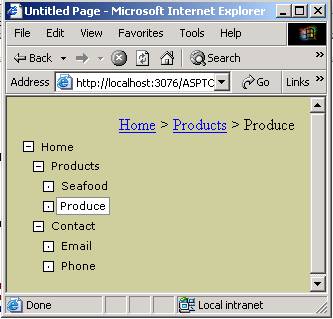The provider design pattern in ASP.NET 2.0 is sweet. I’ve been toying around in the SiteMapProvider area since the first CTP. There is an XmlSiteMapProvider which let’s you describe the navigation and layout of your web site in an XML file like so:
<?xml version="1.0" encoding="utf-8" ?>
<siteMap>
<siteMapNode title="Home" url="Default.aspx" >
<siteMapNode title="Products" url="Products.aspx">
<siteMapNode title="Seafood" url="Seafood.aspx"/>
<siteMapNode title="Produce" url="Produce.aspx"/>
</siteMapNode>
<siteMapNode title="Contact" url="Contact.aspx">
<siteMapNode title="Email Us" url="Email.aspx"/>
<siteMapNode title="Phone List" url="Phones.aspx" />
</siteMapNode>
</siteMapNode>
</siteMap>
Without writing a line of code (just some drag and drop operations), you can give all the pages in your site a tree view of the site hierarchy and a bread crumb control:

What if your site navigation comes from a database table?
NodeID URL Name ParentNodeID ------ ------------- -------- ------------ 1 Default.aspx Home 0 2 Products.aspx Products 1 3 Seafood.aspx Seafood 2 4 Produce.aspx Produce 2 5 Contact.aspx Contact 1 6 Email.aspx Email 5 7 Phones.aspx Phone 5
All you need to do is derive from the abstract class SiteMapProvider and override a handful of methods, like GetParentNode and GetChildNodes. These methods can be straightforward to implement with a few pre-built collections of type Dictionary<string, SiteMapNode>. SiteMapNode objects represent the nodes in the site map, while a Dictionary is one of the exciting new classes from the System.Collections.Generic namespace, which you can use to build strongly typed collections.
One you have some code querying SQL Server and implementing the SiteMapProvider methods, you just need to tell the runtime about your new provider via a config file:
<siteMap defaultProvider="MySqlSiteMapProvider" enabled="true">
<providers>
<add name="MySqlSiteMapProvider" type="SqlSiteMapProvider"
connectionStringKey="ConnectionString"/>
</providers>
</siteMap>
You can have multiple providers for a site. If half of the site navigation information comes from XML and the other half from the database, that’s quite possible. It will be interesting to see what other providers come out. I'm sure SQL, and File System providers will be in demand.

 OdeToCode by K. Scott Allen
OdeToCode by K. Scott Allen